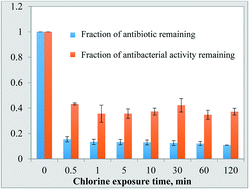Emerging investigator series: transformation of common antibiotics during water disinfection with chlorine and formation of antibacterially active products†
Abstract
This study investigated the effect of chlorine disinfection on the following commonly prescribed antibiotics typically present in treated wastewater: ciprofloxacin, trimethoprim, sulfamethoxazole, levofloxacin and ofloxacin. Antibacterially active transformation products formed from all of the fluoroquinolone class antibiotics: ciprofloxacin, levofloxacin and ofloxacin. Trimethoprim and sulfamethoxazole did not form products with detectable antibacterial activity. Experiments were performed in both ultrapure water and wastewater effluent. HPLC/MS was used to propose the structures of the transformation products in samples where antibacterially active products formed. Both chlorinated and non-chlorinated products were observed. The results indicate that antibiotic transformation products with antibacterial properties form in the wastewater chlorination treatment process. These products may be a source of antibiotic resistance in the environment and warrant a further investigation of their role.

- This article is part of the themed collection: Emerging Investigator Series


 Please wait while we load your content...
Please wait while we load your content...